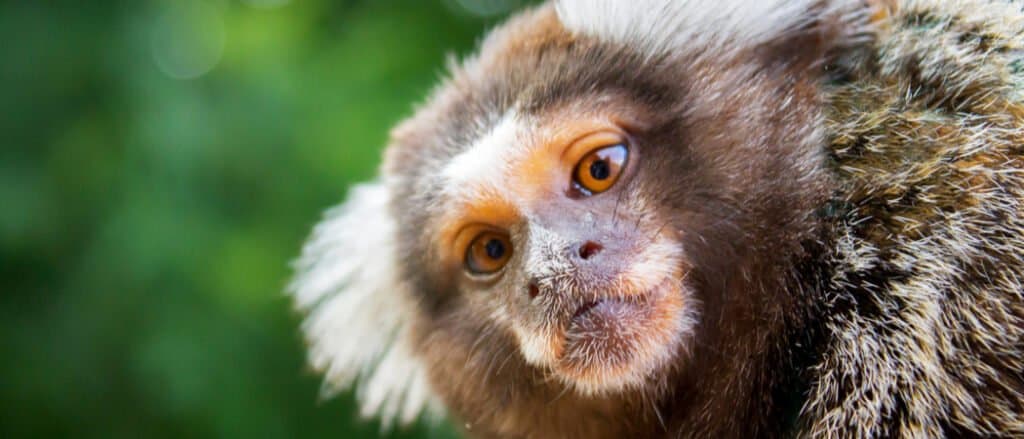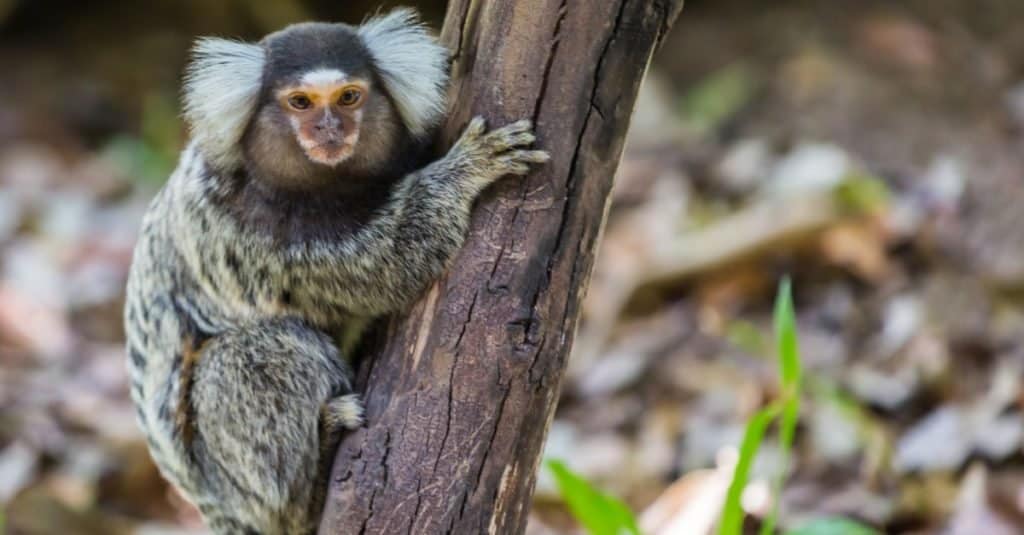If you’ve ever seen a marmoset monkey before, you can surely see the appeal of having these primates as pets. They’re very cute and have an almost squirrel-like quality to them in monkey form. They’re fast monkeys that don’t do well handles but are definitely enjoyable to have around.
So, when it comes down to it, do marmoset monkeys make good pets? The general answer is, unfortunately, no. Marmoset monkeys do not make good pets for a wide range of reasons. In this guide, we’ll break down why marmoset monkeys do not make good exotic pets, as well as a quick history of the marmoset monkey in captivity.
What are Marmoset Monkeys?
The smallest species of monkeys in the world are called marmosets. They spend their days high in the trees of lush rainforests where they dwell in the wild in nations like Peru, Ecuador, Colombia, and Brazil. Even without their long tails, which extend an extra six to nine inches, adults’ bodies are only about six inches long.
Young marmosets can easily cling to a human finger with their entire body since they are so small. The females are often bigger than the males, but both remain fairly little for the entirety of their lives. They have names like the pocket monkey or thumb monkey to their small stature. While marmosets as a whole are not endangered, some species and subspecies are indeed endangered and they can become even more vulnerable if they are unable to adjust to the significant habitat loss they are experiencing.
The marmoset is a very socially-inclined animal, as are the majority of monkeys. They often give birth twice a year, and they dwell in groups. Although single or triplet births are also conceivable, twin births are the most common. The males are largely responsible for rearing their offspring. Offspring are carried about by the fathers during the first two weeks of life and often receive support from other juvenile monkeys in the group.
While they can live up to 22 years in captivity, marmoset monkeys typically only survive 12 to 16 years in the wild. The primary cause of death for wild marmosets is falling from tall trees. They have long, pointed nails that help them cling to branches, and their thin teeth allow them to eat small insects, fruits, and tree sap. They can rotate their heads 180 degrees to look for predators like cats and snakes, which is their main mode of defense. To help them avoid assaults, they can also jump up to 16 feet in the air and are quite fast. They are generally busy throughout the day, playing with other group members, searching for food, and taking care of themselves and their babies.

The marmoset monkey (pictured) can live up to 22 years in captivity.
©donikz/Shutterstock.com
Marmoset Monkeys in Captivity: A Brief History
Since the early 17th century, marmosets have been kept as pets, but they need specialized care to be healthy. And just as well, the not-so-legal trade of marmosets as pets has a very terrible past.
The spread of the marmoset monkey from Brazil’s rainforest biomes into the southeastern Atlantic rainforest region, where they now pose a threat to local marmoset species, was caused by decades of illegal trafficking. One study claims that the invading marmosets interbreed with local species, creating a hybrid population that can cause the indigenous species to go extinct. The buffy-tufted-ear marmoset, also known as Callithrix aurita, is one of the top 25 most endangered primate species in the world. It is a native species of the Atlantic rainforest. The black-tufted marmoset and the common marmoset were frequently traded as pets throughout the 1980s and 1990s, which allowed for their introduction and naturalization in Brazil’s Atlantic rainforests. The majority of the marmosets, who were first bought as pets, were left behind by owners in wooded regions adjacent to major cities, where they proliferated and quickly reproduced.
The issue is that there were already two indigenous species of marmosets present in the southeastern forests when the new primates were brought there. Both are now included on the IUCN Red List as endangered, nearing critical endangerment. Animal trafficking is illegal in Brazil as of 1967, and wildlife trafficking is considered a minor crime under the Environmental Crimes Code of 1988. The amount of animals that are really sold on the black market is impossible to estimate due to the activity’s covert nature. Brazil is said to remove 38 million animals from the wild each year, a heartbreaking 90% of which perish on the way to their destination.
So, to put it simply, the trafficking and selling of marmosets as pets have had severe repercussions for both the animals and the environments in which they were abandoned. That being said, the ownership of marmoset monkeys and monkeys, in general, is legal in many US states, from Wisconsin to Arizona to Texas to Florida. But even though owning a marmoset is largely legal, there are even more reasons not to own one as a pet.

Marmoset monkeys in captivity (pictured) typically don’t do well, especially when adopted alone without a playmate.
Can Marmoset Monkeys Make Good Pets?
Marmoset monkeys, commonly known as finger monkeys, are tiny little creatures that are practically impossible to resist due to their cuteness. Despite the fact that having an exotic pet like the marmoset monkey can seem like fun, most individuals can’t handle the amount of effort involved in caring for these creatures. Although it is technically feasible to keep a marmoset as a pet, the majority of specialists on monkeys would not suggest it.
The concept of owning marmoset monkeys is quite attractive to many, especially exotic animal collectors. After all, they don’t appear like they could make much of a fuss and are smaller than some of the other pets that most humans own. However, no matter how big a monkey is, taking care of one is extremely difficult.
To begin with, depending on where you reside, owning a primate is likely not even permitted. States have different prohibitions on these things, though many states do actually allow pet monkeys. Even if your area does permit it, you would still have to go through the time-consuming procedure of getting a permit and undergoing ongoing inspections to make sure you can give them an appropriate environment.
The cost of the monkeys themselves upon purchase and the hefty costs associated with their way of life is not even included in the budget for obtaining your licenses. For companionship, you should get at least two marmoset monkeys as they prefer to live in packs. It takes far too much interaction with other people to keep these extremely social animals sufficiently mentally and emotionally stimulated. A single monkey can cost up to $10,000, without including the price of a cage, UV lights, or any plants. Take in mind the travel time required to find a veterinarian with experience with exotic animals, as well as the high expense of wellness checkups and diseases that can be transmitted from humans to monkeys and vice versa.
Moreover, “taming” wild monkeys is not possible. Let’s assume you were able to get the necessary permissions and give your pet marmoset a secure place to dwell. As these monkeys are still wild creatures, you never know how they will respond. Like people, individual monkeys have radically diverse personalities, so you never know how one would respond to a life in captivity. They occasionally have the potential to become violent and hurt you, your children, or other pets inside the home. These species’ males are very aggressive, and they have been known to toss their feces around when enraged. It isn’t really all that fun, is it? A monkey is still a monkey, and they are not really possible to tame.
Pet parents will need to make sure that their pet’s cognitive and stimulation demands are addressed, which can be quite challenging, much as with raising a human child. The first few years of a marmoset monkey’s life are a vital period for them to develop both good and negative behaviors since they are extremely intelligent creatures. Once personality traits are formed, they are there for life, therefore you must be prepared to uphold your commitment to nurturing them in the face of misbehavior.
What Do Marmoset Monkeys Eat?
Marmosets consume special marmoset food, as well as fruits, vegetables, grains, nutritious insect varieties, and vitamins. Food is accessible online from specialist stores and your local grocery shop may carry fresh vegetables. However, this diet can be difficult to keep up, as marmoset monkeys are omnivores that eat lots of different foods in high amounts. You could think of it as regularly buying and supplying food for a small human.

Marmoset monkeys (pictured) require a very diverse omnivore diet of vegetables, fruits, and insects.
©konmesa/Shutterstock.com
What Do Marmoset Monkeys Need As Pets?
You might want to think about how difficult it is to duplicate a wild monkey environment if you haven’t already. Monkeys need extra-large enclosures with water, plants, vines, and swings even if they are little, so they can jump, play, and climb much like they would in the wild. They prefer warm environments with a lot of direct sunshine, and marmosets tend to eat a lot of different types of vegetables, insects, fruits, and other plants. A baby marmoset has to be fed every two hours. This is not only a difficult excursion but also one that most regular people cannot afford financially.
The sunny environment we mentioned earlier is vital. Marmoset monkeys need plenty of UV light to survive, or their health could be negatively impacted. If the place you live is not very similar in climate to its natural habitat, this could be fatal for your marmoset monkey.
As depressing as it may be to admit, you probably shouldn’t keep a marmoset monkey as a pet. All of these wild creatures’ waking hours are filled with demands. They won’t get the attention they require in captivity unless you don’t work and can give them a significant percentage of your time. Most aspiring parents also don’t have enough money to support these monkeys for the rest of their lives, as they can live up to 22 years. Marmosets do best in the wild, where they can hang from vines and play with other monkeys. It might be tempting to want to bring these adorable animals home if you’re an animal lover. However, you must put their endearing looks in the back of your mind and consider what would actually make these cute little monkeys actually happy.
It’s definitely unfortunate that these primates make poor pets due to their specific dietary requirements and UV light requirements. While these monkeys are cute and legal to own in many places worldwide, we recommend renewing your pass to your local wildlife habitat or zoo to get your fill of the adorable marmoset monkey.
The photo featured at the top of this post is © Mihai Ivascu/Shutterstock.com
Thank you for reading! Have some feedback for us? Contact the AZ Animals editorial team.






